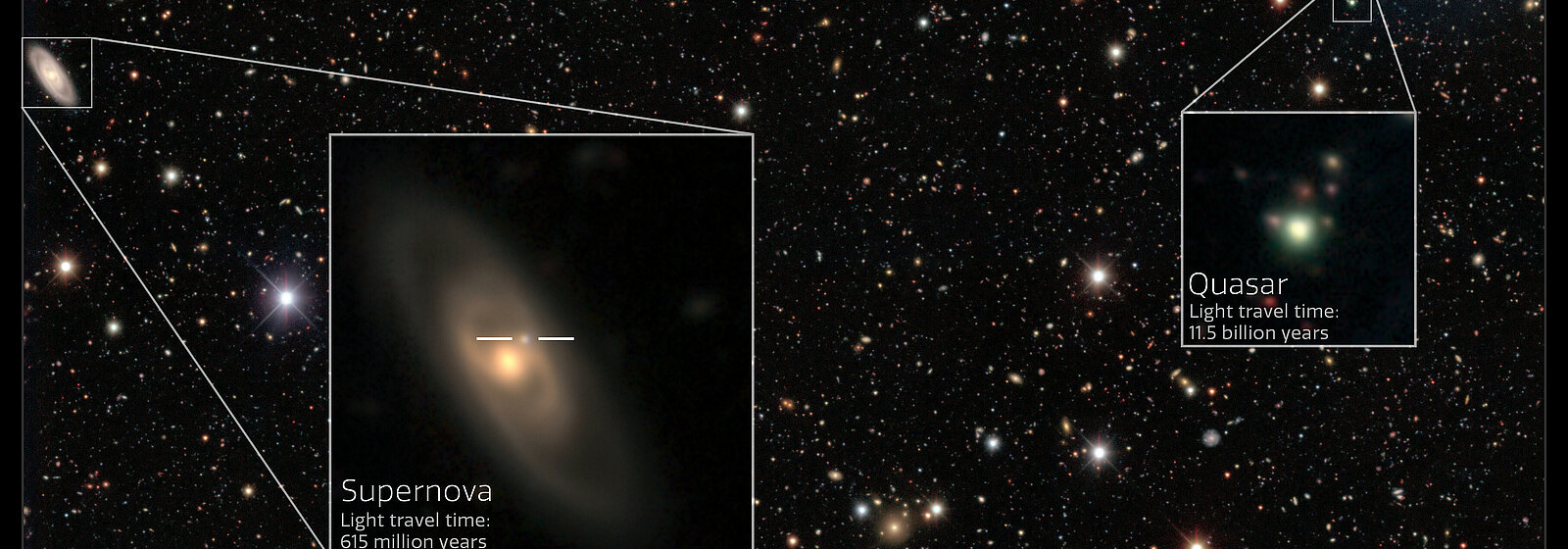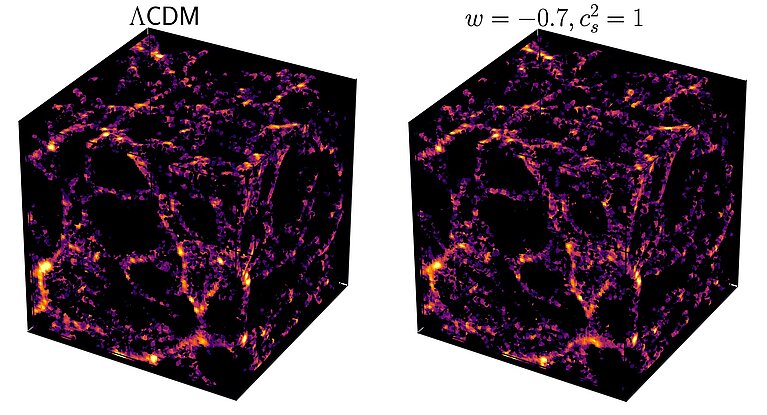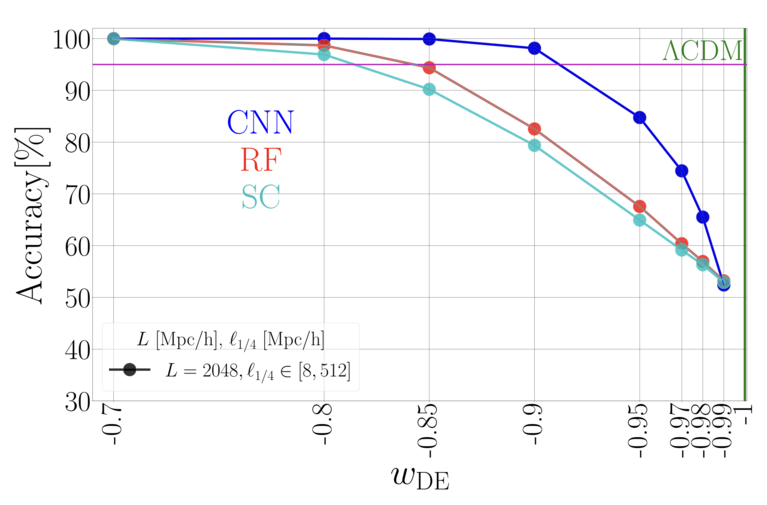May 27, 2025 – by Santina Russo
The universe around us is expanding — faster all the time, in fact. Scientists now know that dark energy is key to explaining this observation. Astrophysical measurements show that visible matter, which makes up the stars and planets, accounts for only 5 percent of the universe’s total mass-energy content. Dark matter is thought to constitute 26 percent, and dark energy 68 percent of the universe.
The concepts of dark matter and dark energy have been around for some time. As early as the 1930s, Swiss astrophysicist Fritz Zwicky hypothesized that galaxy clusters would break apart unless some invisible matter was holding them together. Later, measurements of cosmic microwave background radiation, galaxy rotation, and distribution, as well as distances between supernovae confirmed the existence of dark matter and dark energy. However, their exact nature and physics remain a mystery.
“One widely accepted theory sees dark energy as a cosmological constant, meaning a constant energy density filling space uniformly,” says Martin Kunz, associate professor and group leader in the Centre of Cosmology and Astroparticle Physics at the University of Geneva. However, another theory suggests some dynamic nature in dark energy. Recently, Kunz and his team ran simulations on CSCS’s “Piz Daint” supercomputer that explore a dynamic form of dark energy known as “clustering dark energy”.
Tensions within the standard model
Overall, the idea of a constant dark energy does agree with cosmological observations and is therefore part of the current standard model of cosmology, “Lambda-CDM”. But there are small inconsistencies, or tensions, as they are called in physics — details that do not quite fit. “In cosmology, we welcome such discrepancies because we can learn from them,” states Kunz. “Indeed, the distribution of structures in the universe suggests that dark energy may have changed over the history of the universe.” This means dark energy might not be constant, but dynamic and fluctuating. Recent galaxy surveys even prefer dynamic dark energy over a cosmological constant. The concept of clustering dark energy reflects this dynamic nature and may also better explain the universe’s accelerating expansion.
To incorporate this dynamic form of dark energy, Farbod Hassani, a former PhD student in Kunz’s group, refined the teams’ earlier simulation model by adding a mathematical representation of dark energy based on field theory, which describes the dynamics of a system.
Also, the team’s new simulation model, named “k-evolution”, uses deep learning to detect dark energy. Specifically, the team employs a so-called convolutional neural network (CNN). Such a network maps layers of mathematical functions onto other functions to filter and re-filter the information and ultimately recognize patterns and objects — such as galaxies in space. The resulting galaxy distribution can then be used to infer the distribution of dark matter and dark energy. “Galaxies formed where dark matter is very dense,” Kunz explains. “So, by observing their distribution, we can indirectly trace dark matter and dark energy.”
Seeing invisible matter
For their analyses, Kunz’s team performed a total of 600 universe simulations on “Piz Daint”. Some of the team’s models treated dark energy as a cosmological constant, while others represented varying dynamic forms of clustering dark energy. They then trained their CNN using thousands of sub-portions from these simulated universes.
To evaluate the performance of this deep learning method, the team compared it to a more traditional type of machine learning algorithm known as Random Forest, which combines predefined rules as effectively as possible to classify objects and reveal their distribution.
The results showed that the approach using the CNN outperformed the Random Forest algorithm in accuracy. The team saw up to 40 percent improvement in detecting dark energy in the simulations. In addition, the CNN approach required smaller portions of simulated universe — and thus less data — to achieve a useful prediction accuracy.
The importance of accurate universe simulations
Overall, the work contributes to the general goal of increasing the accuracy of universe simulations. This will be important for interpreting future data from large-scale cosmological surveys, such as those from the Euclid telescope and the Square Kilometre Array Observatory. These instruments, supported by large international collaborations, will soon deliver more precise and comprehensive measurements of cosmic structures than ever before.
“That means simulation models also need to become more accurate to be comparable with the observations,” says Kunz. Such simulations are essential for making sense of observed data, while more accurate observations will ultimately help scientists refine their models. In the future, these developments may reveal what form of dark energy better fits cosmological observations.
Kunz’s results confirm that neural network approaches are a promising addition to state-of-the-art simulation methods. His team is now developing improved models to map additional properties of dark energy. Moving forward, the team plans to represent not only dynamic forms of dark energy, but also how those dynamics evolve over cosmic time. “In recent years, supercomputers and machine learning methods have become more powerful, enabling us to use approaches that were not feasible before,” says Kunz. “I am convinced that such approaches will help us revise our understanding of the universe’s evolution.”
Cover image at the top: A supernova that exploded in a spiral galaxy discovered by the Dark Energy Survey (https://noirlab.edu/public/projects/des/) and on the right, a distant Quasar. Among other things, distances between supernovae confirmed the existence of dark matter and dark energy.
(Credit: Wikimedia Commons, Dark Energy Survey/DOE/FNAL/DECam/CTIO/NOIRLab/NSF/AURA)
Reference
A. Chegeni, F. Hassani, A.V. Sadr, N. Khosravi and Martin Kunz: Clusternets: a deep learning approach to probe clustering dark energy. Monthly Notices of the Royal Astronomical Society (2024), 1534–1545, DOI: https://doi.org/10.1093/


